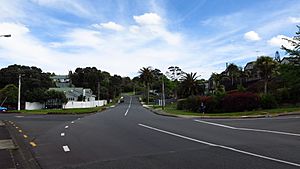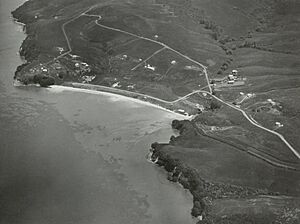Cockle Bay, New Zealand facts for kids
Quick facts for kids
Cockle Bay
|
|
|---|---|
|
Suburb
|
|

Suburban Cockle Bay
|
|
| Country | New Zealand |
| Local authority | Auckland |
| Electoral ward | Howick ward |
| Local board | Howick Local Board |
| Area | |
| • Land | 173 ha (427 acre) |
| Population
(June 2023)
|
|
| • Total | 4,230 |
|
|
||
Cockle Bay is a lovely suburb located in East Auckland, New Zealand. It's part of the Howick Local Board, which is one of Auckland's local communities.
Contents
Exploring Cockle Bay's Location
Cockle Bay is found on the eastern side of Auckland, right by the beautiful Hauraki Gulf. From the bay, you can see the Tāmaki Strait, Motukaraka Island, and the town of Beachlands.
The Rich History of Cockle Bay
Early Māori Life in Tūwakamana
The land around Cockle Bay has a long history with Ngāi Tai ki Tāmaki. This Māori iwi (tribe) arrived in the area around the year 1300 on the Tainui canoe. They called the bay Tūwakamana.
The name Tūwakamana comes from a story about an ancestor named Manawatere. When the Tainui crew arrived, they saw a special red mark on a pōhutukawa tree. This mark showed that Manawatere had been there and that the bay was a good place to live.
Ngāi Tai people grew many crops in the area. The bay was also famous for its large beds of tuangi, which are New Zealand cockles. Even today, Cockle Bay has some of the biggest cockle beds in the Auckland Region.
A special fort called Tūwakamana Pā was built here. It overlooked the Turanga Estuary and helped protect the area. The pā was left empty in 1821 during a time of conflict called the Musket Wars. Many Ngāi Tai people moved away for safety during this period.
European Settlement and Changes
In 1836, a missionary named William Thomas Fairburn arranged a large land sale. This sale covered much of what is now South Auckland and East Auckland. However, Māori people continued to live on their lands as before.
Later, in 1847, the town of Howick was set up. It was a military outpost for Auckland, settled by retired British soldiers and their families. In 1854, a special area was set aside for Ngāi Tai near the Wairoa River. As part of this agreement, Ngāi Tai people moved from their traditional homes closer to Howick.
The first European to own land in Cockle Bay was Reverend Vicesimus Lush in 1853. He used the land for farming.
Cockle Bay as a Seaside Resort
In 1923, the Cockle Bay area was divided into smaller sections. It was advertised as a "seaside resort" called Cockle Bay Estate. The people who moved there formed a close community, separate from Howick.
In the 1920s, many Chinese New Zealanders held large picnics at Cockle Bay. The area was split between Howick and Manukau County. After some disagreements, all of Cockle Bay became part of Howick in 1931. A nine-hole golf course was also built in Cockle Bay in 1934.
After the 1950s, Cockle Bay slowly changed from a holiday spot into a regular suburb of Auckland.
Who Lives in Cockle Bay?
Cockle Bay covers about 1.73 square kilometers. As of June 2023. , it has an estimated population of 4,230 people.
Population Changes Over Time
- 2006: 4,116 people
- 2013: 4,080 people
- 2018: 4,224 people
In the 2018 New Zealand census, there were 4,224 people living in Cockle Bay. This was a small increase from previous years. The median age was 43.6 years. About 18.4% of the people were under 15 years old.
Diverse Community
Cockle Bay is home to people from many different backgrounds:
Many people in Cockle Bay were born overseas (39.5%). This is higher than the national average for New Zealand.
When it comes to beliefs, 47.7% of people said they had no religion. About 41.6% were Christian. Other religions like Hindu, Muslim, and Buddhist were also present.
Many adults in Cockle Bay have higher education. About 31.1% have a bachelor's degree or higher. Most adults are employed full-time or part-time.
Learning in Cockle Bay
Cockle Bay School is a primary school for students in years 1-6. It opened in 1956. The school campus officially welcomed students on March 22, 1958. It originally served Cockle Bay and the nearby rural areas.
For high school, students usually attend Howick College. This school is located in Howick.





